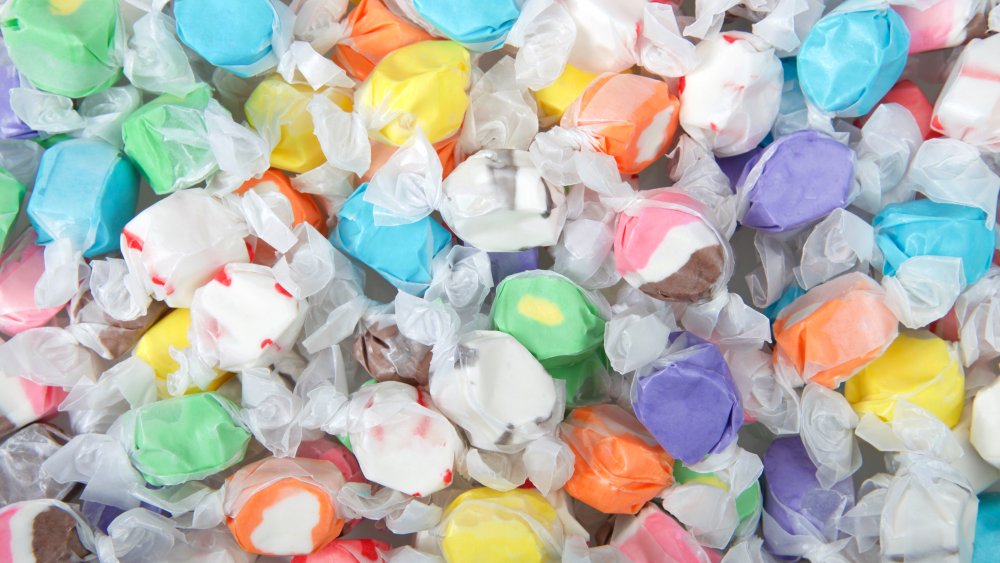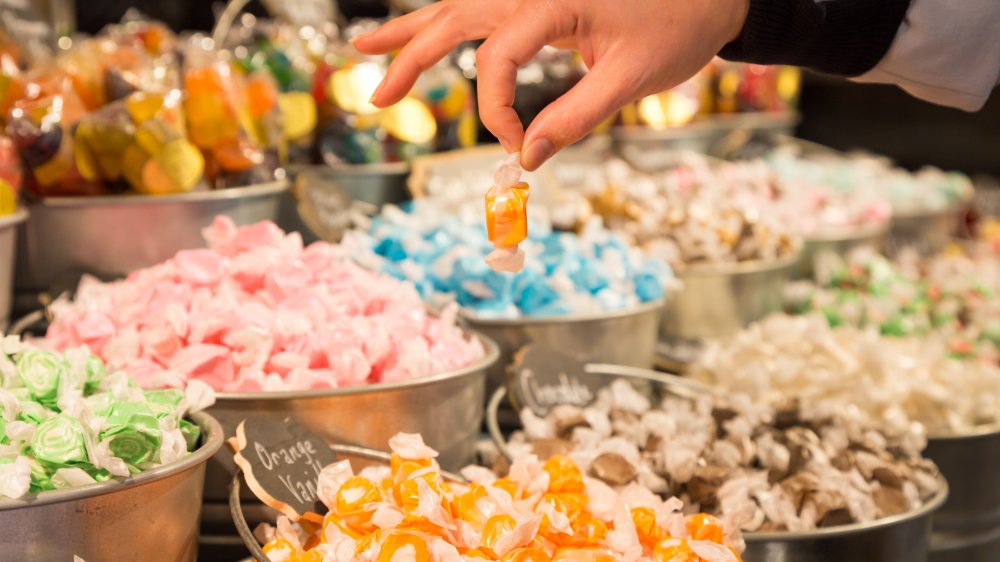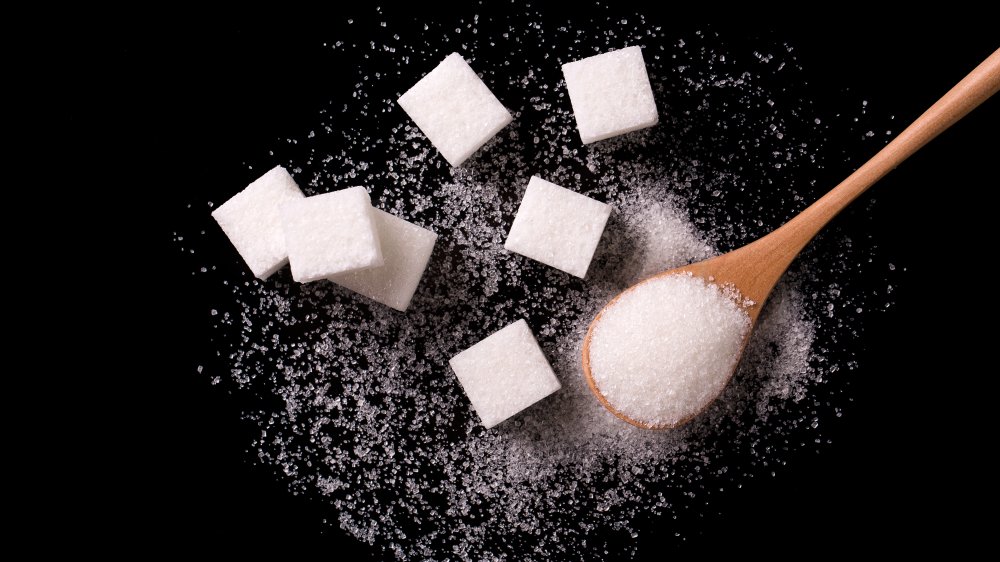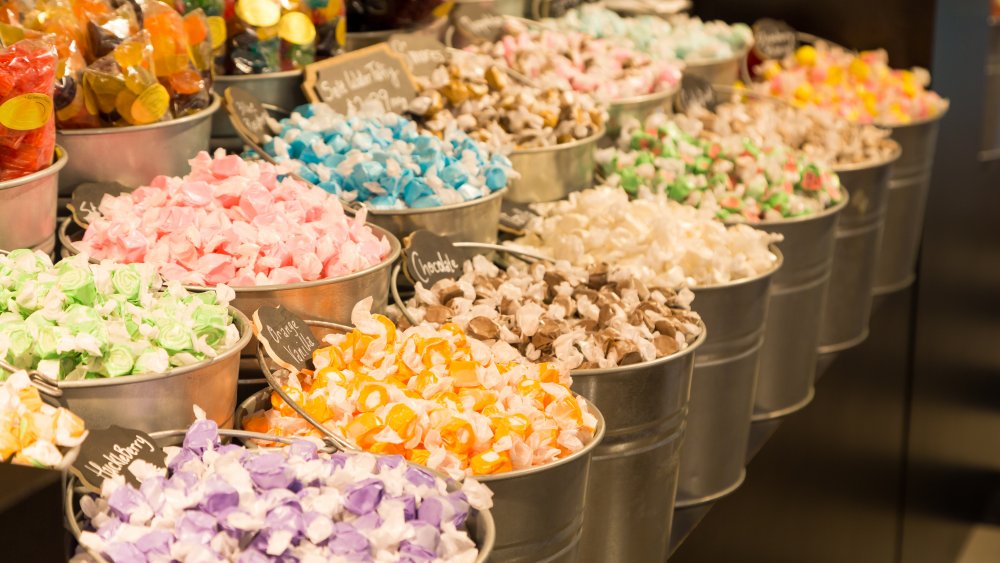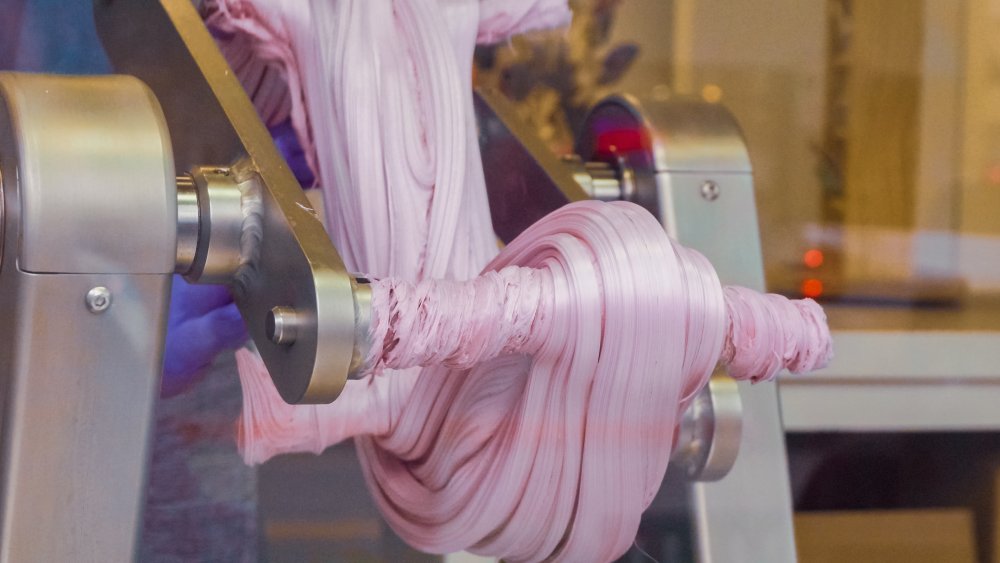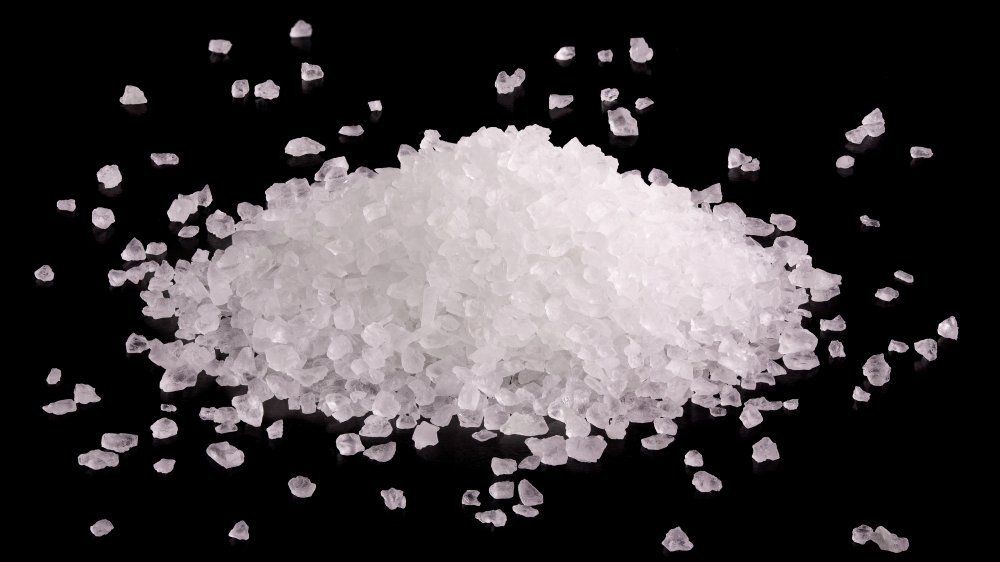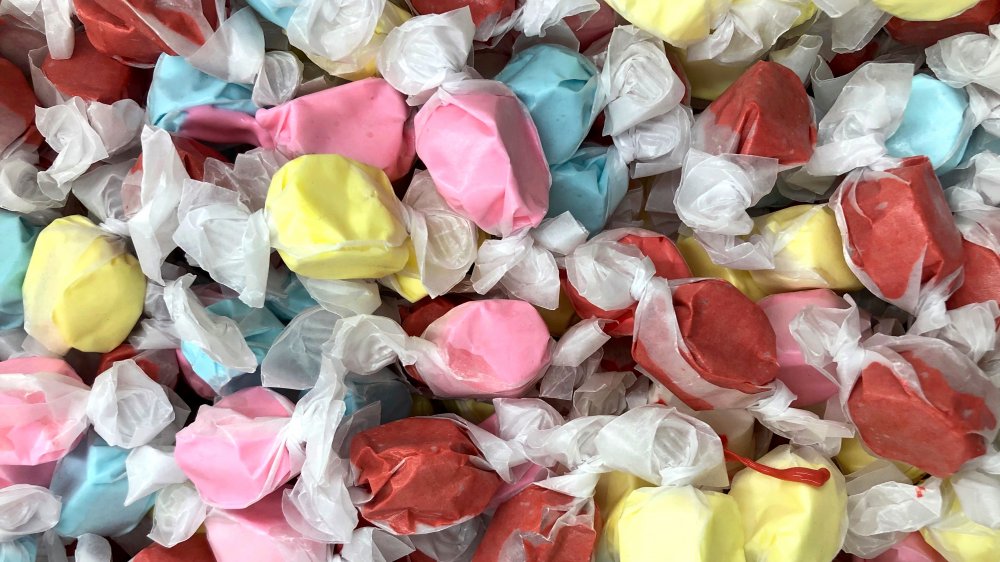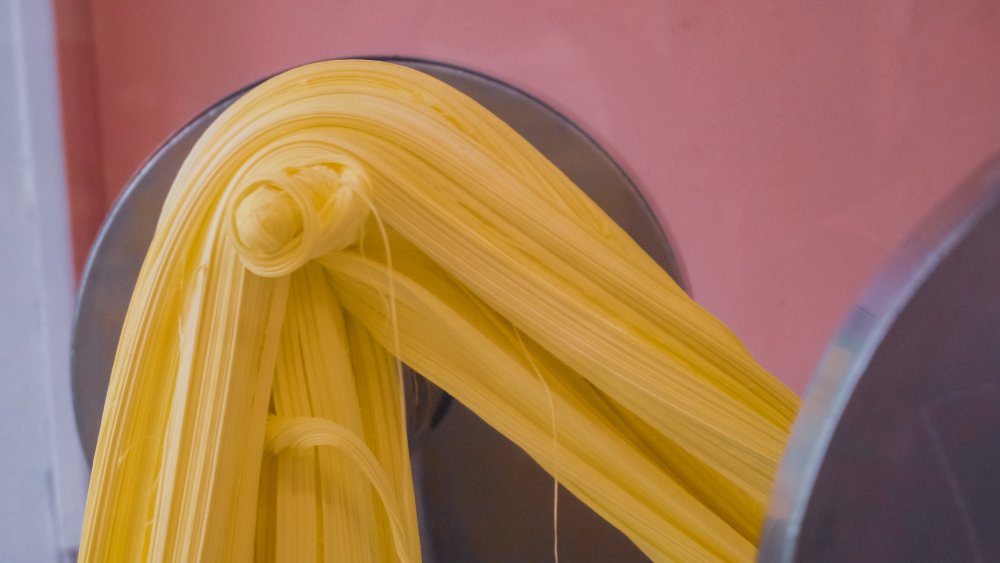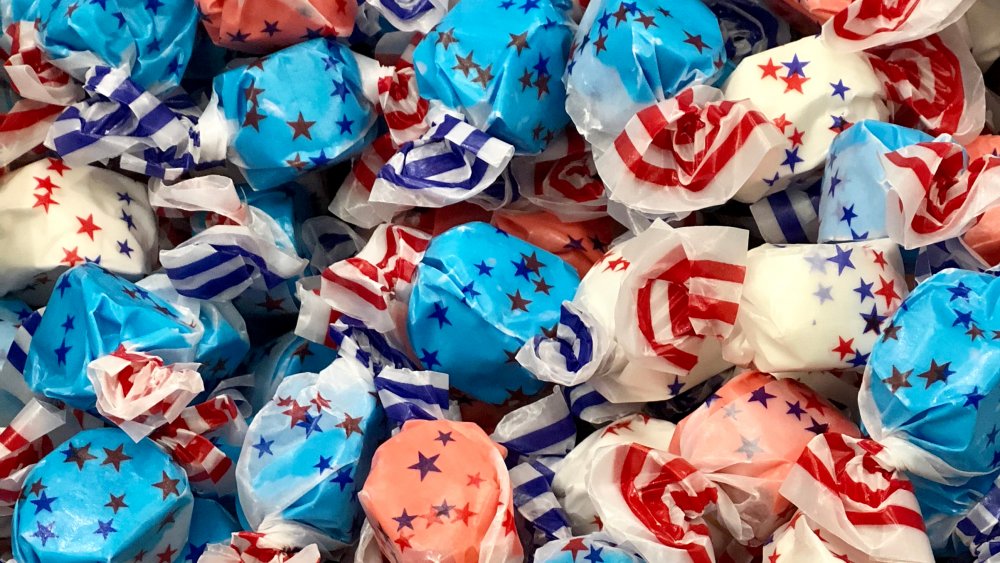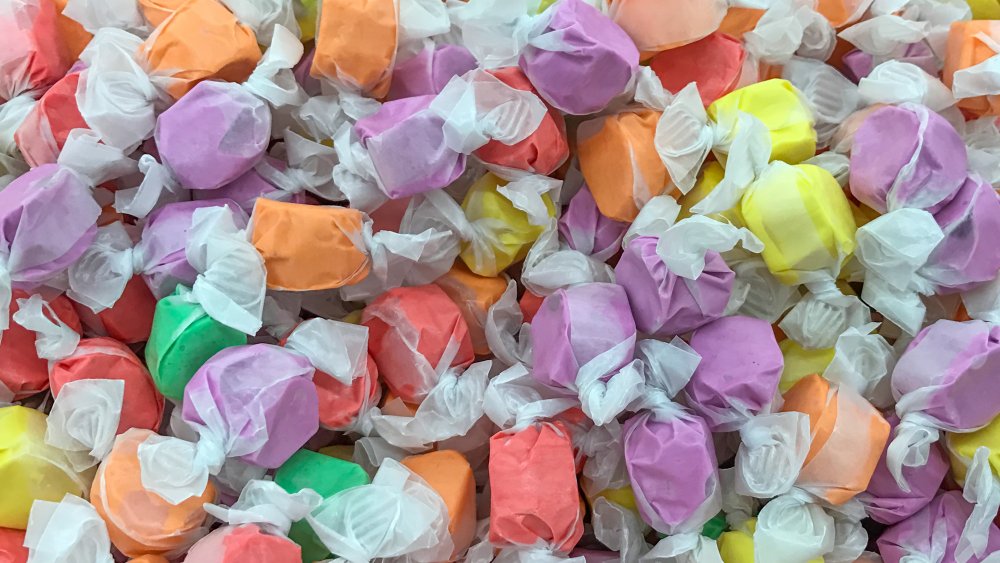The Untold Truth Of Salt Water Taffy
Walking through a candy shop will usually bring you into a whole world of possibilities, and you'll be surrounded by color and an incredible amount of sugar. From gummy candies such as gummy bears and Swedish Fish to jelly beans and chocolates, the candy choices truly are endless. But there's one candy shop staple that has taken the world by storm for decades, often serving as a nostalgic treat for those walking beachside boardwalks or visiting other popular tourist destinations. We're talking about salt water taffy.
Wrapped individually in little wax paper wrappers, salt water taffy is the ultimate sweet summertime treat, with a huge variety of delicious flavors to choose from. It's soft and chewy, serving as the perfect portable candy to bring along while enjoying summer fun. But where exactly did salt water taffy come from? What's the story behind this nostalgic sweet? We decided to dive in to take a look. This is the untold truth of salt water taffy.
Salt water taffy started in Atlantic City
Salt water taffy is one of those sweets that feels like it's been around forever. For many, their childhood memories involve snacking on taffy during a summer vacation or family gathering, and it's been that way for a very long time.
While the official history of salt water taffy is a bit murky, there is one theory that seems to be used the most to explain the development of the sweet, and it all has to do with a major storm that hit Atlantic City in 1884.
During the storm, huge waves came up over the boardwalk, causing the existing businesses to flood with seawater. A man named David Bradley who had been selling taffy in a shop at the boardwalk was affected by the storm. Wiping off the candies, complete with saltwater foam on top, Bradley realized he could still sell his product, despite the outside getting wet. He went on from there to market the candy as salt water taffy.
Salt water taffy is a summer vacation staple
It's pretty challenging to find a person who's never tried a piece of salt water taffy. Whether it's been at the grocery store, in a birthday party favor bag, or most commonly, beachside on the boardwalk during a family vacation, these little pieces of colorful candy are everywhere. But how exactly did salt water taffy become the ultimate summer vacation food? Well, it may all be in the vacation mindset.
Heading to the beach is immediately calming, creating a sense of relaxation, especially since you're likely off work for a week or so. And when candy makers caught on to the salt water taffy name and marketed their products to remind people of the beach, it was a craze that never ended.
We tend to eat a lot more of the stuff on vacation, and the appeal of salt water taffy hooks us. According to USA Today, travelers tend to dive in on things that seem more authentic in the area they're visiting. And while salt water taffy truly can be made anywhere, it's the nostalgic feeling it evokes that keeps us coming back on that annual summer vacation.
Salt water taffy is made with a whole lot of sugar
When you eat candy, you know what you're getting yourself in to. You're getting into a whole lot of sugar. But just how much are you eating when you're enjoying a few pieces of salt water taffy?
Salt water taffy is made with sugar, corn syrup, sweetened condensed milk, water, butter, oil, emulsifier, and sometimes salt. Then, the flavoring and coloring are added as well.
A seven-piece serving of taffy contains 23 grams of sugar. And while that number may not seem like a lot, it certainly is when compared to the daily recommended amount of sugar we should all be consuming. According to the American Heart Association, the daily recommendation for consuming sugar is 36 grams for men and only 25 grams for women. Of course, salt water taffy is usually consumed on vacation when you're feeling a bit more care-free, but is a whole day's worth of sugar worth it?
There's a ridiculous number of flavors of salt water taffy
As with any candy, salt water taffy comes in a huge variety of flavors. But when it comes to offering a super-wide variety of flavors, salt water taffy truly is in a whole other league of its own in the candy world.
Online retailer Taffy Shop reports that it offer overs 70 different flavors of salt water taffy (and that's just one shop), but there are a few favorites that come in at the top of the list. The shop's top-selling flavors include peppermint, vanilla, banana, watermelon, frosted cupcake, and cotton candy.
And Taffy Shop's delicious-looking slew of flavor options certainly extends to other shops, which also offer countless fruity flavors along with dessert-focused options such as strawberry cheesecake, caramel apple, cinnamon roll, and Neapolitan ice cream. Add in flavors like rum, apricot, and citrus spice, and there's truly a piece of taffy to grab for just about everyone.
The process of making salt water taffy has come a long way
Making taffy is a fascinating process. It requires the perfect mixture of sugar, corn syrup, and other ingredients to be heated to a specific, ideal temperature. Then, that mixture is folded and pulled, similar to the process of kneading bread.
During the pulling process, the taffy is being aerated, which is what introduces little air bubbles into the candy, ultimately giving taffy its chewy and light characteristics. That process of hand-pulling, quite literally stretching the candy with two hands, was the way taffy was made for years.
Luckily, the process has been mechanized over the years. Taffy producers have candy maker Enoch James to thank for the mechanization of salt water taffy production after he figured out a way to utilize machinery to pull the candy, resulting in a product that wasn't as sticky. Now, the ingredients for the taffy are mixed together in steel kettles, cooked twice, and then moved over to machines that do all of the pulling and packaging. And with the change in equipment, manufacturers can now make 1,000 pieces of salt water taffy per minute.
Salt water taffy doesn't really have much salt
The fact that we all call it salt water taffy might lead to some confusion. For many who haven't tried this soft and chewy sweet, they may believe they're about to bite into a fruit-flavored piece of candy with a salty kick. And especially for flavors such as frosted cupcake, adding the overwhelming flavor of salt into the mix just sounds pretty gross.
But the name "salt water taffy" is definitely misleading, as salt water taffy barely utilizes any salt at all. Yes, there's certainly a bit of water and salt added to the recipe, but the amount of salt in most taffy recipes is very minimal. In fact, salt water taffy company Shriver's doesn't add any salt at all to its recipe (except for just a pinch in the peanut butter flavor).
Just be warned: If you've never had this treat before, don't expect this dessert to be salty or savory in any way (unless you order a weird flavor).
Salt water taffy has a surprising amount of fat
Of course, it goes without saying that candy isn't exactly health food. After all, candy is generally jam-packed with sugars and carbohydrates, adding up to plenty of calories. But when it comes to some candies on the market, it's not uncommon to see claims on the packaging of being "low-free" or "fat-free," like those you'll find on Twizzlers licorice and Swedish Fish packages. But that's certainly not the case for salt water taffy.
Not all salt water taffy is made from the same recipe, but most are fairly similar, and most of them consist of sugar, corn syrup, and butter or oil. A typical serving of salt water taffy, which is about seven pieces, has two grams of fat. And while that number may not seem astronomical, it is high when you consider how small and nutritionally lacking these candies are. We can thank all the butter and corn syrup that goes into our favorite salt water taffy flavors for that.
Frank Sinatra really liked salt water taffy
Truth be told, we can all probably get on board with eating copious amounts of salt water taffy. It's sweet and chewy and so delicious ... until you end up with a stomach ache, of course.
In the late 1970s, Atlantic City was experiencing a huge surge of tourists as it legalized casinos. Other events, such as concerts and boxing matches, started popping up around the area due to the increased traffic from the casinos, and the city began to draw crowds. Not only was salt water taffy said to be born in Atlantic City, it also found its home there amongst bands of hungry tourists on the hunt for a sweet treat.
It also seemed to have drawn the attention of famed singer Frank Sinatra after a performance at Resorts International. In 1978, Sinatra ordered more than 500 boxes of salt water taffy from a well-known local Atlantic City candy company, taking the record for the biggest single mail order of this popular sweet. But, don't worry, he didn't sit in his hotel room and eat all of that taffy on his own. He had ordered the boxes of salt water taffy in his favorite flavors (vanilla, chocolate, and strawberry) to be delivered to his friends and relatives as a commemoration of his show in Atlantic City.
Salt water taffy-pulling parties used to be real events
While the process of making salt water taffy has been mechanized, there certainly are still people who pull it by hand at home. That may not sound like an exciting way to spend an afternoon to you, but there are people out there who organize parties around this activity alone.
Taffy pulling is hard work, requiring constant movement of your hands and arms. So it wouldn't be so bad to have a little help to make the process easier, right? And that's exactly what people did in the 1800s.
Getting people together to make salt water taffy was common, even popular, especially at colleges and churches. Guests would gather to boil the candy and then, yes, pull it. This was considered a fun activity for men and women, young and old alike. It may not sound like your typical Friday night these days, but the appeal is definitely there. There are worse things to do at a party than play with sugary goop. Plus, you get to eat the candy in the end, so what's not to like about that?
Soldiers ate salt water taffy during World War II
During World War II, candy companies wanted to provide soldiers overseas with a steady supply of candy, and salt water taffy was often a part of those care packages.
Because taffy is made with plenty of sugar and corn syrup and wrapped up individually in paper, it's an easy product to ship without worrying about damage to the item or the potential for significant melting. And getting the candy to the soldiers was actually far more of a priority than you might think.
During World War II, many food rations were put into place, and Americans needed a government-issued food coupon to buy sugar, along with coffee, meats, cheeses, and other products. Given that ration, some taffy makers would make as much taffy as possible to send to armed forces, and then they'd close their doors when the sugar ran out until they could refill their rations. Talk about a sweet commitment.
You can make your own salt water taffy
While it's certainly tradition to head to the beach boardwalk and take salt water taffy home with you, there is a solution if you can't make it out to the sea. You have to curb that craving some way, right?
As it turns out, you can actually make salt water taffy on your own at home. And unsurprisingly, it requires a whole lot of sugar.
Candy makers at home can mix together sugar with cornstarch, butter, corn syrup, salt, water, and vanilla extract to make the candy. Once the mixture comes together, allow it to cool, and then the real fun begins. Making it at home will allow you to try your hand at stretching taffy, folding the mixture over itself multiple times, and creating a roll to cut pieces from. It'll definitely require a candy thermometer to get the right temperature for the candy, but it may be worth it to have a taste of the seaside at your own home.
